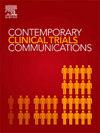提高临床试验代表性的社区卫生工作者外展和导航网络(CONNECT)模型的可行性:提高临床试验代表性的社区医生参与方法
IF 1.4
Q4 MEDICINE, RESEARCH & EXPERIMENTAL
引用次数: 0
摘要
尽管努力增加临床试验(CT)中的种族和民族代表性,但少数民族参与者的纳入仍然不足。为了解决无效外展和减少机会的障碍,我们开发了一个名为社区卫生工作者外展和导航网络的项目,以增强临床试验中的代表性(CONNECT)。本文描述了CONNECT及其在3个月内实现的可行性。方法CONNECT的核心是专门的文化和语言协调的ct培训社区卫生工作者(CHW)和当地社区医生。CHW嵌入当地社区医生的实践中,他们在一对一的接触中教育患者ct。CHW随后跟进患者,协助转介到符合患者兴趣的CT。我们的主要结果是患者的开放性和适合CT,这是由CHW转介到CT所证明的。CHW与约150名患者中的74名(49%)进行了一对一的会面,并将74名参与者中的62名(84%)转介到符合他们偏好的ct。结论:我们的研究证明了CONNECT模型对于增加代表性不足人群CT转诊的开放性和适用性的可行性。加强与社区医生的关系,服务于广泛的患者群体,并在他们的实践中嵌入CHW,教育患者有关CT的知识,可能是增加对CT参与的开放性和支持的重要途径。我们发现CHWs可以弥合研究信任差距,促进对CT参与的开放,并创造适合参与者偏好的CT参与机会。本文章由计算机程序翻译,如有差异,请以英文原文为准。
The feasibility of the Community health worker Outreach and Navigation Network for Enhancing representation in Clinical Trials (CONNECT) model: A community-physician engagement approach for increasing representation in clinical trials
Background
Despite efforts to increase racial and ethnic representation in clinical trials (CT), inclusion of minoritized participants remains inadequate. To address the barriers of ineffective outreach and reduced opportunities, we developed a program called Community health worker Outreach and Navigation Network for Enhancing representation in Clinical Trials (CONNECT). This article describes CONNECT and its feasibility of implementation over a 3-month period.
Methods
At the core of CONNECT is a dedicated culturally and language concordant CT-trained Community Health Worker (CHW) and local community physician. The CHW was embedded in a local community physician's practice, where they educated patients about CTs during one-on-one encounters. The CHW then followed up with patients to assist with referral to a CT that fit patients' interests. Our primary outcome was patient openness and fit for CTs as demonstrated by a CHW referral to a CT.
Results
The CHW met with 74 of ∼150 patients (49 %) one-on-one and referred 62 of the 74 participants (84 %) to CTs that fit their preferences.
Conclusion
Our study demonstrates the feasibility of the CONNECT model for increasing openness and fit to CT referrals for underrepresented populations. Strengthening relationships with community physicians serving wide-ranging patient populations and embedding a CHW in their practice to educate patients about CTs may be an important pathway for increasing openness to and support for CT participation. We found that CHWs can bridge the research trust gaps, facilitate openness to CT participation and create accessible opportunities to participate in CTs that fit participant preferences.
求助全文
通过发布文献求助,成功后即可免费获取论文全文。
去求助
来源期刊

Contemporary Clinical Trials Communications
Pharmacology, Toxicology and Pharmaceutics-Pharmacology
CiteScore
2.70
自引率
6.70%
发文量
146
审稿时长
20 weeks
期刊介绍:
Contemporary Clinical Trials Communications is an international peer reviewed open access journal that publishes articles pertaining to all aspects of clinical trials, including, but not limited to, design, conduct, analysis, regulation and ethics. Manuscripts submitted should appeal to a readership drawn from a wide range of disciplines including medicine, life science, pharmaceutical science, biostatistics, epidemiology, computer science, management science, behavioral science, and bioethics. Contemporary Clinical Trials Communications is unique in that it is outside the confines of disease specifications, and it strives to increase the transparency of medical research and reduce publication bias by publishing scientifically valid original research findings irrespective of their perceived importance, significance or impact. Both randomized and non-randomized trials are within the scope of the Journal. Some common topics include trial design rationale and methods, operational methodologies and challenges, and positive and negative trial results. In addition to original research, the Journal also welcomes other types of communications including, but are not limited to, methodology reviews, perspectives and discussions. Through timely dissemination of advances in clinical trials, the goal of Contemporary Clinical Trials Communications is to serve as a platform to enhance the communication and collaboration within the global clinical trials community that ultimately advances this field of research for the benefit of patients.
 求助内容:
求助内容: 应助结果提醒方式:
应助结果提醒方式:


